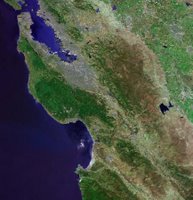This old bobcat that hangs out near the bridge by the corral at Wilder State Park is my favorite. It's also the only one of my bobcat friends that is photographically cooperative. Wilder is a great California State Park on the coast at the northern end of the Monterey Bay and an example of a new trend in park management in the western US (The BLM spearheaded this approach in the 1970's in the California Mojave Desert led by Senator Alan Cranston). Instead of trying to make all types of visitors happy everywhere in the park (and failing to make anyone happy), they try to accomodate specific activities at specific locations or even at specific parks. Wilder State Park is part Childrens Petting Zoo, Historical Park, Horse Ranch, and Mountain Biker Paradise. While some impressive distance runners train there in the hills most of the trail occupants are bicyclists. Horses have the right of way, and bikers must yield and pass sensitively, but there are relatively few horses to cope with. Hikers are few and far between. And there is lots of wildlife. Coyotes, bobcats, and lots of mule deer. Once I almost collided with a six point buck bounding across the trail. There are even rattlesnakes. My son and I spotted a 15 cm rattler a couple of weeks ago that was less than a year old.
I have been meaning to put together a decent website on Wilder for years, but have only managed to assemble a time-lapse photo tour of one of the main bike routes I follow. http://kibak.com/WilderRicoh/index.htm The first photos are climbing the hill at UCSC as the map indicates.
It's also interesting to view this ride as a quick slideshow at
http://www.flickr.com/photos/kibak/sets/72057594127107482/ October
http://www.flickr.com/photos/kibak/sets/72057594130673567/ May
The photos were taken at 3 minute intervals, so setting the slide show speed to 1.8 seconds will give you a 1:100 time compression.
